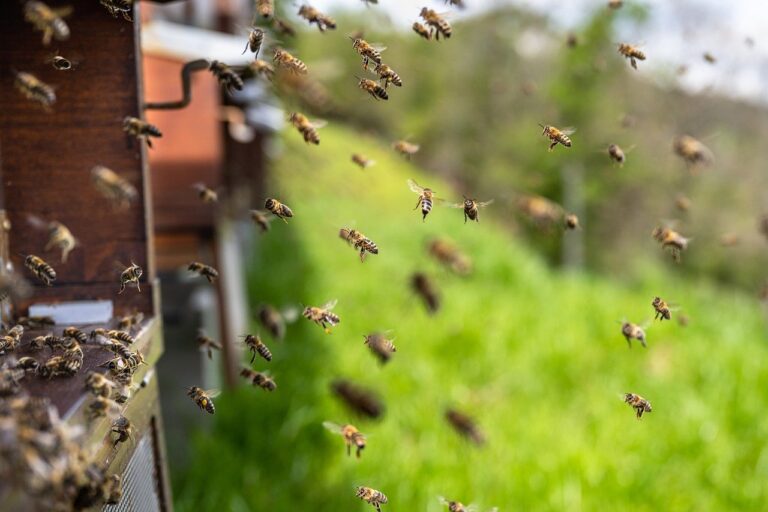Bee extinction is the scenario where all or a significant portion of bee species cease to exist, leading to their complete disappearance from the natural ecosystem. This would have severe consequences for pollination, biodiversity, and the overall health of various ecosystems.
Bees, the small yet vital pollinators, play an indispensable role in maintaining the delicate balance of our ecosystems. However, these invaluable creatures are facing an alarming extinction risk, posing significant dangers to our environment and food security.
In this article, we explore the reasons behind the bee extinction risk and the potential dangers it poses to the world.
Table of Contents
Why are bees endangered?
Bees are exposed to danger due to a combination of factors, often referred to as the “Bee Decline” or “Colony Collapse Disorder” (CCD). Some of the primary reasons for bee endangerment include:
1. Pesticides: The use of harmful pesticides, particularly neonicotinoids, has been linked to bee population declines. These chemicals can harm bees’ nervous systems, affecting their ability to forage and navigate;
2. Habitat loss: Urbanization, agricultural expansion, and deforestation have led to the loss of natural habitats for bees. This reduces their access to food sources and nesting sites;
3. Parasites and diseases: Bees face threats from various parasites and pathogens, such as Varroa mites and fungal infections, which weaken and kill bee colonies;
4. Climate change: Changing climate patterns and extreme weather events can disrupt the natural life cycles of plants and bees, affecting their synchronized interactions and availability of food;
5. Nutritional stress: Monoculture farming practices can limit the diversity of available floral resources, leaving bees with insufficient nutrition;
6. Pollution: Air and water pollution can negatively impact bee populations and their ability to survive and thrive.
Which bees are at the risk of extinction?
Eight species of bees have been formally designated as endangered, even though the majority of bee species have experienced significant population declines over the past 300 years, and that 40% of invertebrate pollinator species are in danger of going extinct.
Thankfully, not all bee species are at risk of extinction, however, they are all experiencing severe population declines as a result of human activities and climate change.
Here is the list of a few endangered bees:
Rusty Patched Bumblebee (Bombus affinis), Hawaiian Yellow-Faced Bees (Hylaeus spp.), Franklin’s Bumblebee (Bombus franklini), The Western Bumblebee (Bombus occidentalis), The Suckley cuckoo bumblebee (Bombus suckleyi).
What would be the aftermath of bee extinction?
Given the significant contribution bees make to our agricultural systems through pollination, their extinction would probably cause a global food crisis.
1. Impact on agriculture: Many crops, such as fruits, vegetables, nuts, and oilseeds, rely on bees for pollination. Without bees, these crops would have reduced yields or failed to produce fruits altogether, leading to a decline in food production;
2. Food shortages: As a significant portion of the global food supply depends on pollination by bees, their extinction could lead to food shortages. This would affect not only human populations but also animals that rely on these crops for sustenance;
3. Ecosystem disruptions: Bees are not only essential for agricultural purposes but also for maintaining biodiversity and ecological balance. They support various plant and animal species in their habitats. The loss of bees could disrupt these ecosystems and lead to imbalances in the natural world.
How can we prevent bee extinction?
Preventing bee extinction requires a combination of individual and collective efforts.
- Habitat preservation: Bees need diverse and suitable habitats to thrive. Preserving natural habitats, such as wildflower meadows, forests, and grasslands, provides bees with a variety of food sources and nesting sites. Encouraging the protection of green spaces in urban areas can also support bee populations;
- Reduction in pesticide use: Pesticides, especially neonicotinoids and other harmful chemicals, can be lethal to bees and other pollinators. Adopting integrated pest management practices that minimize pesticide use and choosing bee-friendly alternatives can help protect their populations;
- Planting of bee-friendly flowers: Planting a diverse range of flowers that bloom throughout the growing season can provide bees with a continuous food supply. Choose native plant species, as they often offer better food sources and nesting opportunities for local bee populations;
- Supporting organic agriculture: Organic farming practices generally avoid synthetic pesticides and prioritize natural methods to manage pests. By supporting organic agriculture, consumers can contribute to a safer environment for bees and other beneficial insects;
- Raising awareness: Educating the public about the importance of bees and the threats they face is crucial. Awareness campaigns can inspire people to take action, support bee-friendly initiatives, and advocate for better protection of pollinators;
- Beekeeping practices: Sustainable and responsible beekeeping practices can help maintain healthy bee colonies. Beekeepers should prioritize the well-being of their hives, avoid over-harvesting honey, and take measures to prevent the spread of diseases that can affect bee populations.
Bee extinction risk demands immediate attention
The decline in bee populations and the subsequent extinction risk are issues that demand immediate attention and action. Without bees, the intricate web of life that sustains our planet could be severely disrupted.
The consequences of bee extinction would extend beyond ecological concerns, affecting global food security and economic stability. Therefore, by safeguarding bees, we are securing our future and that of generations to come.












